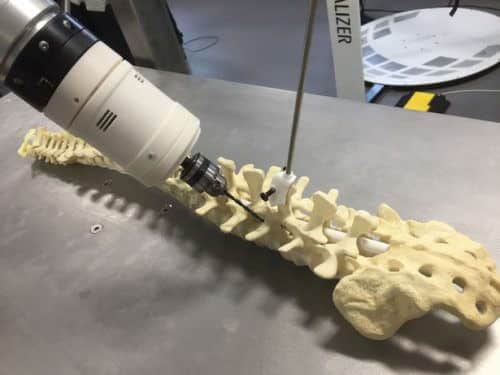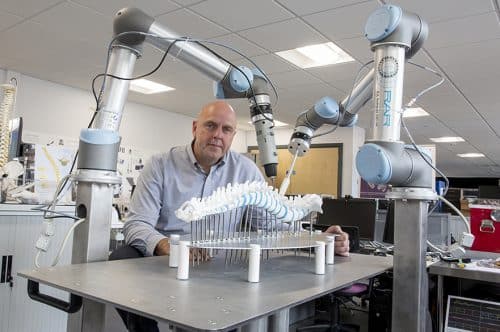A new robot, currently being developed at NTU University in Nottingham, UK, will in the near future improve the accuracy of drilling vertebrae during back surgeries and help correct spinal deformities. The robot named Scoliobot is equipped with two Universal Robots model UR5 robotic arms and during the surgery the team also uses smart glasses. The developers estimate that the day will not be far away and the system will be able to perform a variety of complex spine surgeries with much greater precision than today.

A new robot, currently being developed at NTU University in Nottingham, UK, will in the near future improve the accuracy of drilling vertebrae during back surgeries and help correct spinal deformities. The robot named Scoliobot is equipped with two Universal Robots model UR5 robotic arms and during the surgery the team also uses smart glasses. The developers estimate that the day will not be far away and the system will be able to perform a variety of complex spine surgeries with much greater precision than today.
In the first stage of the medical process, the patient's spine is scanned to locate the source of the problem and understand the exact location of the deformity that needs treatment. According to the data, the surgeon guides the Scoliobot to the appropriate position and locks it in place - at the point where the surgery needs to be performed. One of the two robotic arms that take part in the process is attached to the spine and moves along with the patient's natural movements, transmitting information about the nature of the movement to the computer. The other arm sticks to the track and automatically performs the required drilling in the treated vertebra with great precision. According to the data of the key team, it is an accuracy of 0.1 millimeter. At the end of the drilling, the surgeon can insert the appropriate screws into the drills to align the damaged part.

Today, there are several robot-assisted systems on the market for performing spine surgeries, including that of the Israeli company Mazor Robotics, which was recently purchased by Medtronic. In Mazor's technology, part of the control over the drilling is still in the hands of the surgeon. According to Prof. Philip Brydon, from the NTU research team, the surgical robot is currently in the research and testing stages when the experiments are conducted on XNUMXD printed spine models. "The XNUMXD models are a perfect replica of the human spine and they were scanned in patients with real problems," he says. "Our challenge today is to completely eliminate the delay between the two arms and ensure that they are in an optimal position to perform real surgeries."
Another innovative technology was used during the research: augmented reality. Using smart glasses and augmented reality technology, the surgeons receive visual feedback, which demonstrates exactly to what depth the drilling is actually performed. "We still have a lot of work ahead of us," says Prof. Brydon, who estimates that in less than five years the system will be used in field conditions. "The modern technologies we use have great potential for reducing the risks to patients, as the precision of the surgical procedure will be higher and more perfect, a figure that cannot currently be achieved by the human hand. Our move is an excellent example of how the use of cobots (collaborative robots) can streamline and improve the way this type of surgery will be performed in the near future."
